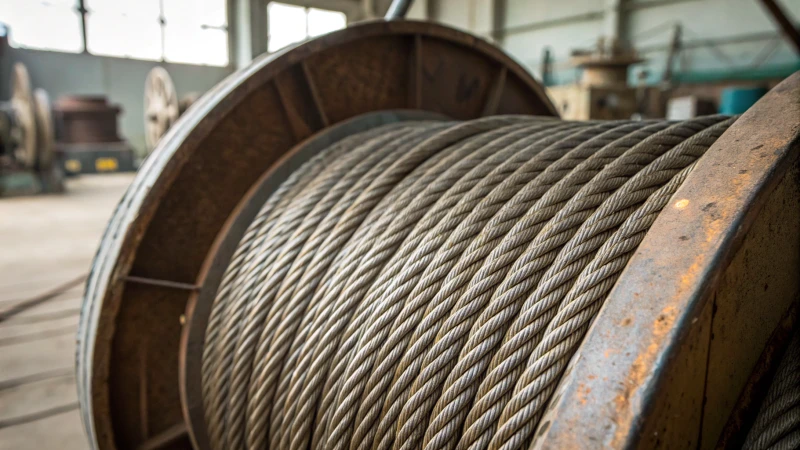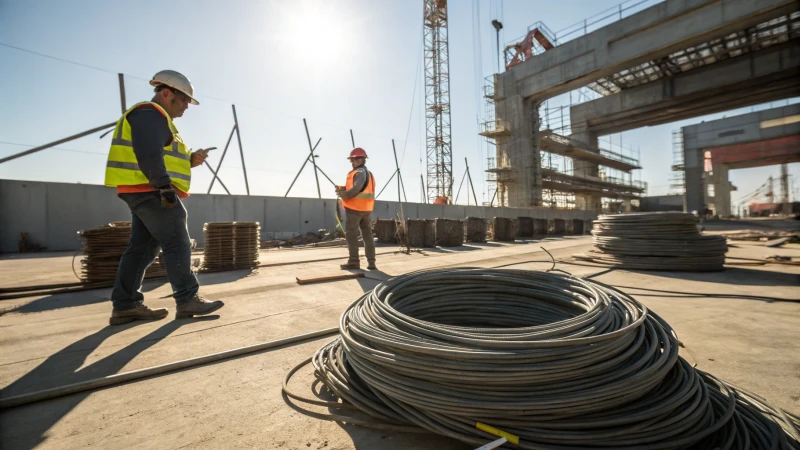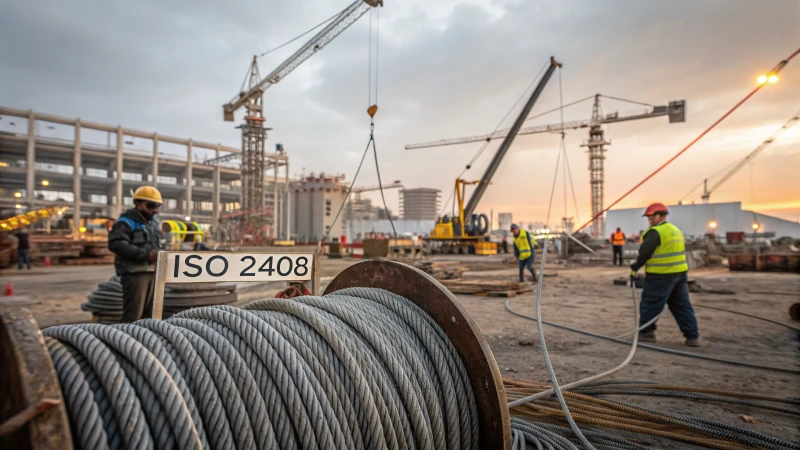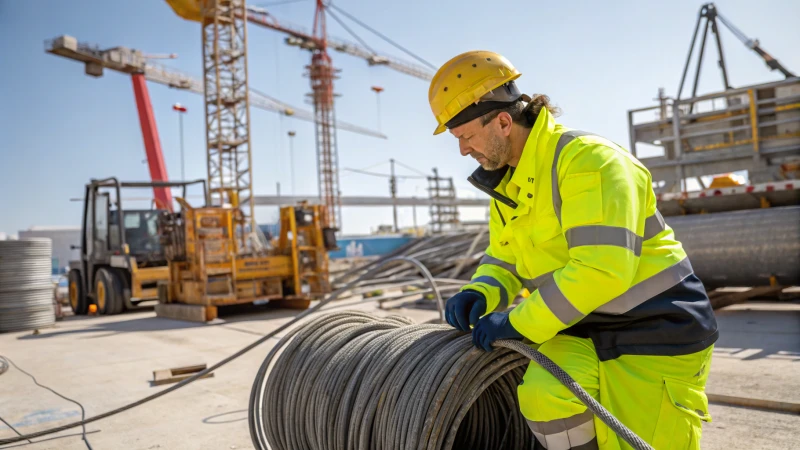
Have you ever wondered what makes heavy-duty steel wire ropes so reliable?
Heavy-duty steel wire ropes must meet ISO 2408 and OSHA standards to ensure safe load handling, minimizing accident risks and legal liabilities.
When I first started learning about steel wire ropes, I was amazed by how much detail goes into ensuring their safety and reliability. It's not just about strength; it's about meeting those crucial standards that make a difference between a successful lift and a potential disaster. In this post, I'll walk you through the key safety standards like ISO 2408 and OSHA regulations, showing you how they apply to the ropes we rely on daily. Understanding these can transform how you approach procurement and usage, enhancing both safety and efficiency in your operations.
ISO 2408 is a standard for steel wire ropes.True
ISO 2408 specifies requirements for the manufacture and testing of steel wire ropes.
OSHA regulations do not apply to steel wire ropes.False
OSHA regulations include safety standards for using steel wire ropes in workplaces.
Why Are Safety Standards Crucial for Steel Wire Ropes?
Have you ever found yourself on a construction site, watching those massive cranes lift heavy loads with ease? That’s the power of steel wire ropes meeting safety standards.
Safety standards for steel wire ropes are crucial because they ensure these ropes can handle the required loads without failure, minimizing risks in critical operations like construction and mining. Compliance significantly reduces accidents and enhances overall safety.

Understanding Safety Standards for Steel Wire Ropes
Picture this: I’m on a bustling construction site, the kind where everything from skyscrapers to bridges is born. Amidst the clang and clatter, the one thing that stands out is the reliability of our steel wire ropes. These aren't just any ropes—they're crafted to meet rigorous standards like ISO 2408 and OSHA regulations. These rules aren't just bureaucratic red tape; they’re the reason why each rope can handle stress without snapping under pressure. They ensure that when we lift, everything stays in place, safeguarding both the team and the machinery.
The Role of Standards in Risk Mitigation
I’ve seen firsthand how adhering to safety standards transforms a construction site. It’s about more than just compliance; it's about peace of mind. Non-compliance can lead to catastrophic outcomes—legal headaches1, financial losses, and most importantly, jeopardizing lives. I remember a colleague who once said, "You never really appreciate a good safety standard until it saves a life." It's true. Following these guidelines not only keeps everyone safe but also protects the company's reputation.
Importance in Different Industries
Steel wire ropes are like unsung heroes across various sectors:
- Construction: They're the backbone of cranes and lifts, handling loads with unmatched tensile strength.
- Mining: Deep underground, these ropes resist corrosion and endure immense loads.
- Marine: Out at sea, ropes battle harsh marine environments2, proving their worth through strict safety adherence.
| Industry | Key Requirements |
|---|---|
| Construction | High tensile strength |
| Mining | Corrosion resistance |
| Marine | Resistance to saltwater exposure |
The Business Perspective
For businesses like mine, sticking to safety standards is about building trust. When clients see our commitment to quality and safety, they know they're in capable hands. It’s not just about compliance; it’s about enhancing our reputation and showing that we care. Plus, it saves us money in the long run by preventing costly accidents and equipment failures. I’ve learned that investing in safety is investing in success.
Continuous Monitoring and Compliance
Keeping up with safety standards isn’t a one-time checklist—it’s an ongoing commitment. I’ve implemented regular inspections and maintenance routines to catch wear and tear early. We even train our team on proper handling techniques to ensure everyone knows how to spot potential issues before they escalate. It's these efforts that keep our operations running smoothly and safely.
ISO 2408 applies to steel wire ropes.True
ISO 2408 provides international standards for steel wire ropes.
Marine industry doesn't need safety standards.False
Marine industry requires strict compliance with safety norms for ropes.
How does compliance with ISO 2408 enhance safety?
Ever wondered how a global standard like ISO 2408 could be your secret weapon for safety and reliability?
Following ISO 2408 ensures steel wire ropes meet high safety and performance standards, significantly reducing failure risks during crucial lifting operations. This standard offers detailed guidelines for manufacturing, testing, and using these ropes, ensuring they are durable and dependable.

Understanding ISO 2408
As someone who’s had to make the tough calls on construction sites, I know that the safety of every piece of equipment can weigh heavily on my mind. That's why I lean heavily on standards like ISO 2408. This international standard is all about ensuring steel wire ropes3 can handle the demands of lifting and hoisting tasks. It outlines everything from their construction to their mechanical properties, ensuring that they can endure the pressures they're put under.
When manufacturers stick to these guidelines, they’re not just ticking boxes—they’re guaranteeing that their products are safe to use. It's like having a trustworthy friend who always has your back when the stakes are high.
Benefits of Compliance
| Benefit | Description |
|---|---|
| Risk Mitigation | Let me tell you, there's nothing more nerve-wracking than the thought of a rope failure during a critical operation. Compliance with ISO 2408 greatly reduces these risks, helping us avoid accidents and the chaos they bring. |
| Quality Assurance | Knowing that every batch of ropes meets the same high standards is a huge relief. It means consistency, which is exactly what I need when I’m managing large-scale construction projects4. |
| Global Recognition | With ISO standards recognized worldwide, it feels great to know that my company can compete internationally by showing our commitment to quality and safety. |
Practical Implications
Safety Protocols: In my experience, embedding ISO 2408 practices into our operations means rigorous checks at every production stage—testing raw materials, validating designs, and conducting regular inspections.
Training and Certification: I've found that training employees on ISO 2408 requirements not only boosts their confidence but also ensures compliance. Certifications keep everyone on the same page about safety.
Regular Maintenance: Following ISO guidelines for maintenance is like having a roadmap to keep our equipment in top shape over time. Auditing maintenance records keeps us accountable and aligned with industry standards.
Implementing these practices has been a game changer for us. By prioritizing compliance, we not only enhance our safety protocols5 but also ensure our products consistently meet and exceed industry expectations.
ISO 2408 is only applicable to steel wire ropes.True
ISO 2408 specifically addresses standards for steel wire ropes used in lifting.
Compliance with ISO 2408 guarantees zero rope failures.False
While it reduces failure risks, compliance doesn't eliminate all potential rope failures.
How Does OSHA Ensure Wire Rope Safety?
Have you ever wondered who's looking out for your safety when working with wire ropes?
OSHA plays a critical role in wire rope safety by setting standards for specifications, maintenance, and inspections to prevent workplace accidents. Adhering to OSHA guidelines ensures safe lifting and rigging operations, reducing risks significantly.

My Journey with OSHA's Wire Rope Standards
I still remember the first time I walked onto a construction site and saw those massive cranes hoisting materials high into the sky. It was both awe-inspiring and a bit nerve-wracking. The wire ropes, crucial in such operations, seemed like the unsung heroes of the day. Back then, I knew little about what kept these operations running smoothly and safely—until I dug into OSHA's safety standards.
OSHA, or the Occupational Safety and Health Administration, provides a set of comprehensive guidelines that have become my go-to resource. Their standards cover everything from the exact specifications that wire ropes must meet to their maintenance and inspection protocols.
Detailed Guidelines for Wire Rope Safety
- Specifications: According to OSHA, wire ropes need to conform to specific criteria regarding size, strength, and construction. This ensures they can handle the heavy loads typical on job sites.
- Maintenance: I learned early on that maintaining these ropes is key. OSHA advises regular checks for wear, corrosion, or broken wires. Overlooking this could lead to severe safety hazards.
- Inspection Frequency: One of the trickiest parts was figuring out how often these inspections should take place. OSHA's guidelines vary based on usage and environment, but more frequent checks are recommended in harsh conditions.
Here's a quick reference table:
| Component | Requirement |
|---|---|
| Specifications | Must meet specific size and strength criteria. |
| Maintenance | Routine inspections for wear, corrosion, or damage. |
| Inspection | Varies based on usage; more frequent in harsh conditions. |
Why Comply with OSHA?
Following OSHA's regulations doesn't just enhance safety; it also makes economic sense6. Companies that align with these standards often see fewer accidents and benefit from lower insurance premiums and less downtime. Plus, a strong safety record can boost a company's reputation significantly—something I've seen firsthand in projects I've managed.
Training for the Best Practices
OSHA offers various training programs to ensure everyone is up to speed with safe practices around wire ropes. These programs have been invaluable in teaching my team proper inspection techniques and safe operation procedures. Investing in regular training7 has paid off in spades by keeping our workforce safe and operations smooth.
Looking Ahead: Innovations in Safety
The future of wire rope safety is exciting. With advancements in technology, I expect OSHA will soon incorporate smart monitoring systems into their guidelines—tools that offer real-time assessments of rope conditions like smart monitoring systems8. Staying updated with these trends is something I strive for to ensure compliance and efficiency in all my projects.
OSHA mandates wire ropes meet specific size criteria.True
OSHA requires wire ropes to adhere to certain size and strength standards.
OSHA does not require regular inspections of wire ropes.False
OSHA specifies routine inspections to ensure wire ropes remain safe.
How can businesses ensure ongoing compliance with safety standards?
Navigating the maze of safety standards can feel daunting, but it's crucial for keeping everyone safe and sound. Let's explore how to make compliance less of a chore and more of a routine.
Businesses ensure ongoing compliance by regularly auditing safety protocols, investing in employee training, leveraging technology for real-time monitoring, and staying updated on regulatory changes. These practices help prevent accidents and maintain legal adherence.

I remember the first time I was tasked with ensuring compliance at our firm. It felt like being handed the keys to a labyrinth with no map. But over time, I realized it wasn't about doing everything at once; it was about setting up a rhythm.
Conducting Regular Safety Audits
One of the first rhythms I established was conducting regular safety audits. It's like checking under the hood of your car before a long trip. You want to catch potential issues before they turn into roadblocks. Having qualified personnel carry out these audits ensures an unbiased view of what's really going on. And tools like digital audit software9 make it all less overwhelming, transforming what could be a cumbersome process into something manageable.
Investing in Employee Training
Training is another cornerstone. I can vividly recall the first training session I organized—it was nerve-wracking! But seeing everyone engage and learn how to handle emergencies made it worthwhile. Interactive workshops and online courses, like those available through e-learning solutions10, can make learning accessible and engaging for everyone involved.
Utilizing Technology for Monitoring
Embracing technology was a game-changer for us. I remember setting up wearable tech and sensors across our site, which felt like stepping into the future. These gadgets provide real-time data that help prevent accidents before they happen. Implementing smart safety solutions11 became a vital part of our strategy, allowing us to maintain a safer work environment.
Keeping Updated with Regulatory Changes
Lastly, staying updated with regulatory changes is non-negotiable. We subscribed to industry newsletters and participated in forums that discussed updates on regulations like OSHA and ISO. This was akin to having a weather app that alerts you before a storm hits. A subscription to industry compliance updates12 ensures we are always informed about new standards.
| Strategy | Benefit |
|---|---|
| Regular Safety Audits | Identify hazards early, ensure adherence to protocols |
| Employee Training | Equip staff with necessary skills and knowledge |
| Technology Utilization | Real-time monitoring and predictive analytics |
| Regulatory Updates | Maintain current compliance, adapt to new requirements |
By weaving these practices into the fabric of our daily operations, not only do we ensure ongoing compliance, but we also cultivate a culture of safety and responsibility. It’s about creating an environment where everyone feels valued and protected.
Regular safety audits identify potential hazards.True
Safety audits are designed to uncover hazards, ensuring protocols are followed.
Employee training is optional for safety compliance.False
Training is essential to equip employees with necessary safety skills.
Conclusion
Heavy-duty steel wire ropes must comply with ISO 2408 and OSHA standards to ensure safety, reliability, and risk mitigation in critical lifting operations across various industries.
-
Learning about legal liabilities emphasizes the importance of adhering to safety standards to avoid costly legal issues. ↩
-
Explore how marine conditions impact ropes to ensure they are suitable for saltwater use. ↩
-
Learn about the specific requirements of ISO 2408 for steel wire ropes to ensure compliance and safety. ↩
-
Discover why complying with ISO 2408 is vital for safety in construction projects using wire ropes. ↩
-
Explore recommended safety protocols for maintaining compliance with ISO 2408. ↩
-
Discover how adhering to OSHA standards can lead to cost savings through reduced accidents and insurance premiums. ↩
-
Explore available training programs that can help your team safely manage wire ropes. ↩
-
Learn about innovative technologies that can enhance wire rope safety through real-time monitoring. ↩
-
Discover how digital audit software can streamline your safety audits and enhance compliance. ↩
-
Explore top e-learning platforms that offer comprehensive safety training for employees. ↩
-
Learn about innovative smart safety solutions that improve monitoring in industrial settings. ↩
-
Stay informed about the latest OSHA and ISO updates by subscribing to industry newsletters. ↩

